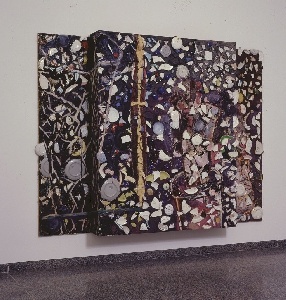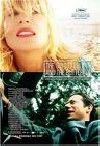The Diving Bell and the Butterfly, A French Film Directed by Julian Schnabel
New York City Art Bad Boy Morphing into Auteur Or Keeping All the Plates in the Air
By: Mark Favermann - Dec 26, 2007
Directed by Julian SchnabelStarring Mathieu Amelric, Emmanuelle Seigner, Marie-Josée Croze, Anne Consigny Max von Sydow, and Olatz Lopez Garmendia (Mr. Schnabel's wife)
1h52m,
In French with English subtitles
Now showing at The Coolidge Corner Theatre, Brookline, MA and other selected art cinemas,
Julian Schnabel is known as the broken plate artist. Like some sort of artistic shooting star, the emergence of media savy artist Schnabel was a phenomenon of the hyper-commercially-motivated art world in the 1980s. Once considered the bad boy of the New York City art scene, Schnabel seemed to rise up out of nowhere. Schnabel's ability for self-promotion propelled him into the limelight. This appears to have happened again as his art star has dimmed and movie directing has become Schnabel's primary focus.
Looking for the next new thing, Schnabel's art was quickly assigned by trendy art critics and curators to the emerging neo-expressionism style of contemporary painting. Neo-expressionism was a style of painting that emerged in the late 1970s and dominated the art market until the mid-1980s. It developed in Europe as an alternative to the conceptual and minimalistic art of the 1970s. It was certainly a lot easier to sell.
Neo-expressionists painting portrayed recognizable objects, such as the human body (although sometimes in a virtually abstract manner), in a rough and violently emotional way using vivid colors. Other painters grouped with Schnabel are Americans Jean-Michel Basquiat, Eric Fischl, David Salle as well as the Italians Francesco Clemente and Sandro Chia. Personally, I never thought any of them could draw very well, but they worked boldly on dramatically large canvases. Big was somehow good, I guess.
Schnabel's first major exhibition was at Mary Boone Gallery in 1980. By the time he exhibited his work in a show jointly organized by Boone and Leo Castelli in 1981, his signature works, both abstract and figurative, had as a base surface either black velvet or broken crockery. It was said at the time that Schnabel's quick rise to popularity became representative of the money-driven 1980s. His notoriety exemplified the commercialization of the art world that related to the economic boom.
Considered somehow heroic, with his charismatic and eccentric personality, Schnabel became a visual art superstar. He worked in pajamas, slippers, and robe to present himself as an individual and mad genius. Like other hot artists before him, he instinctively understood self-promotion and the marketplace working it well. This led to a little controversy. His persona, carefully hyped, often outshone the artwork itself, which inspired debate by a few, perhaps more perceptive, critics as to whether it actually held artistic merit.
At the time, to the trendy art-buyers, Schnabel's work was highly desirable, and his exhibitions often sold out. Some less knowledgeable critics actually judged Schnabel's success as an artist based on the incredible demand for his work. With the recession of the late 1980s, and the stabilization of the economy in the 1990s, Schnabel's art star faded. Maybe people with money got better advice about what art to invest in? Yet, Schnabel's work is in many prominent museum collections. It should be noted that over the last two hundred years, arrogant and perhaps incompetent museum curators have historically made many comparable mistakes in their acquisitions.
In the last decade or so as his visual art stock went down, Julian Schnabel has transformed himself into an auteur, a film director whose work is so distinctive that he is considered the creator of the film. Previously, he made two well received biopics. One , "Basquiat," about drug addict, category-killer artist, Jean-Michel Basquiat and the other, "Before Night Falls," an episodic look at the life of the gay Cuban poet and novelist, Reinaldo Arenas. Good not great reviews followed each film. The artist as director was newsy even if the films were at times very uneven. But, somehow, with his third film, "The Diving Bell and the Butterfly," the old Schnabel hype has hit again.
Some critics have marveled at the imaginative way that this film was visually made (mostly through the eyes of a one eyed, quadriplegic, stroke victim); others feel this film exemplifies the best of movie-making with its imaginative use of image over content; while some have even commented upon its emotional exhilaration describing it as a special film. The Cannes Film festival bestowed its Best Director 2007 award upon Schnabel. But, he had made the film in French, and how many French films are being made lately, especially by Americans? The French, remember, honor Jerry Lewis as a comedic genius. Personally, I feel that it is not a great film, but a very good one. It is also rather elegantly restrained for something Julian Schnabel has been involved with artistically.
The film is based upon The Diving Bell and the Butterfly which is a translation of the French memoir Le Scaphandre et Le Papillon by former journalist Jean-Dominique Bauby. He was referred to by his friends and relatives as Jean-Do. The book describes what his life after suffering a massive stroke at 42 that left him in a near vegetative state condition called Locked-In syndrome. Prior to the stroke, he was the urbane editor of French Elle, a father of three (with a woman that he was not married to) had a mistress (very French), was a devoted son to a decrepit elderly father, and
possessed a strong sense of humor that somehow survived the stroke.
The book was dictated by Bauby blinking only his left eyelid. A super patient literary stenographer repeatedly recited a frequency-ordered alphabet, until Bauby blinked to choose the appropriate letters to form his words. Supposedly, the book took about 200,000 blinks to write and each word took approximately two minutes. The chronicler was miraculous in her own right.
Bauby not only records everyday events and what they are like for a person with locked-in syndrome, but he also includes being at the beach with his family, getting bathed, and meeting friends and visitors. It also describes the inner imagination (the butterfly) of the author as well as his locked-in turmoil (the Diving Bell). The book was published in France on March 6, 1997. It received excellent reviews and sold 150,000 copies in the first week. Ten days after the French version of the book was published, Bauby died at 43.
Other films such as My Left Foot and The Sea Inside have created a kind of locked-in small film genre. These films with the hero as victim can be tear-jerking or induce manipulative resentment. Instead of emotional manipulation, Schnabel's approach uses visuals to create and convey physical limitations, as well as the wide range of Bauby's consciousness and inner imagination. The director worked with Steven Spielberg's primary cinematographer, Janusz Kaminski, to employ a wide array of lenses, cinematic styles, and sensitive lighting to underscore his own artistic vision. How much was either man's individual artistic vision probably never will be told.
I do have a few gripes. There are just too many beautiful women in the film. Seriously. This is done perhaps consciously to suggest the erotic vision of the trapped man, however, this leads to visual confusion between the various characters. Secondly, I understand Max von Sydow adds gravitas to the cast and acting. However, he lately always seems to play Max von Sydow as he plays here beyond Jean-Do's dad character. Max is a little Biblical lately in screen presence as well. This is certainly OK for Nelson Mandela or Alexander Solzenitzen, but not an actor playing a rather average old man. Thirdly, after such visual beauty, the last major image of the film, the one burned into our memory, is rather horrible. What's up with this, Mr. Schnabel?
The Diving Bell and the Butterfly is not about hope or even some sort of temporary glory, but instead about imagination and cherishing the inner being. The body may crumble, but life somehow goes on. This time, Schnabel has managed to keep all the plates spinning in the air.




